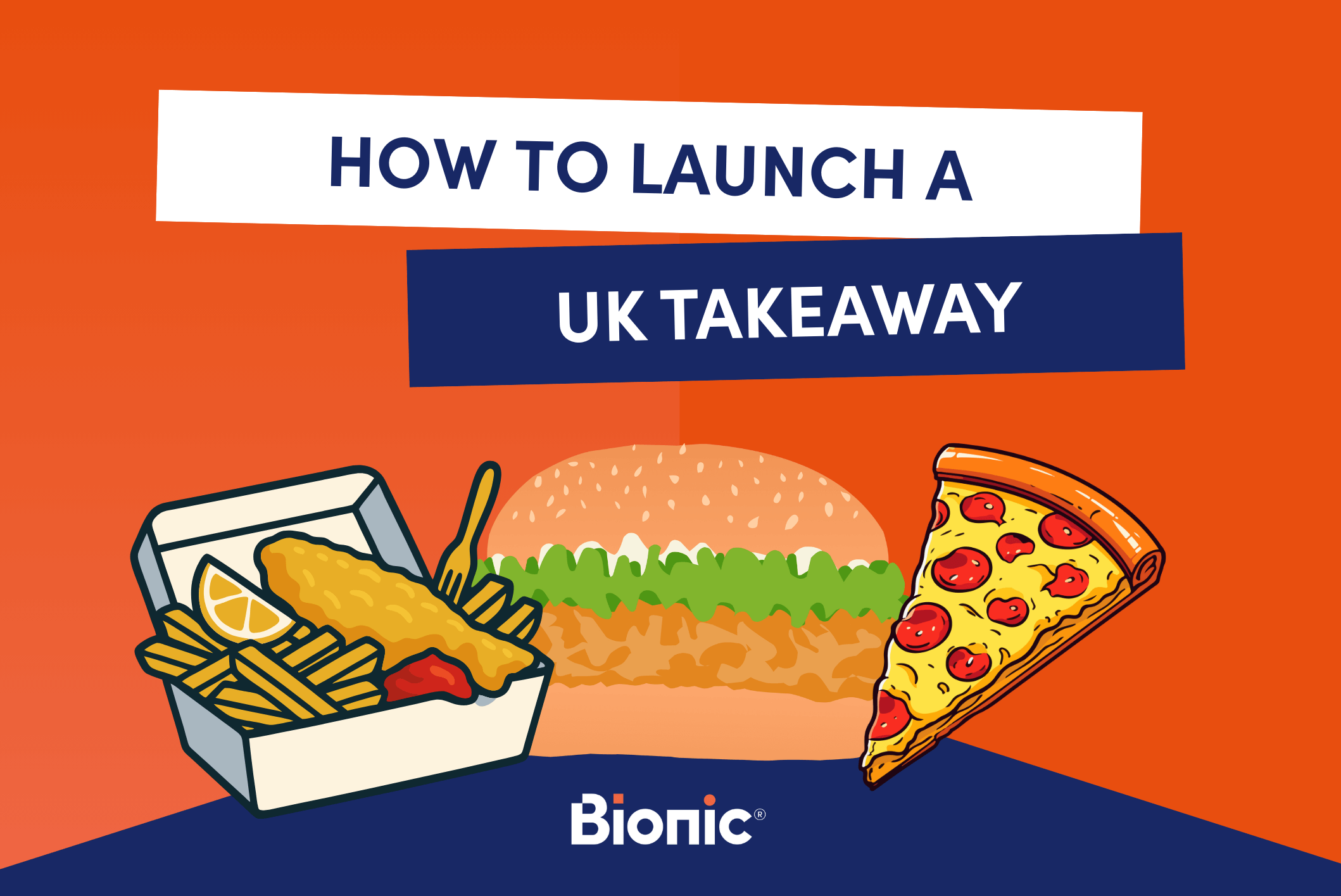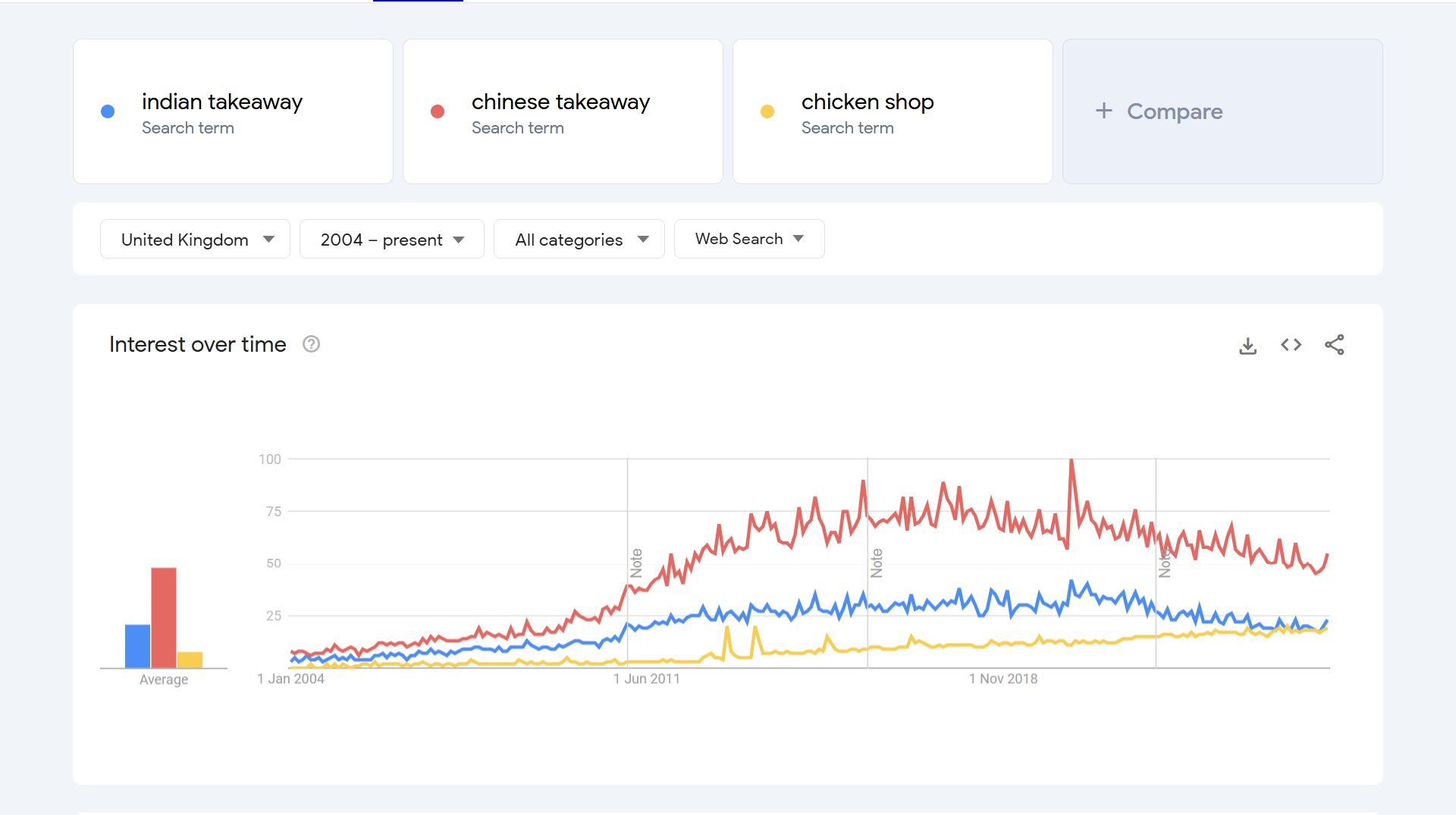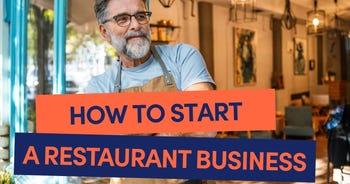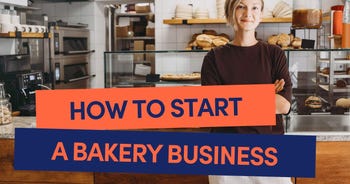Launching your takeaway in 2025/26: A complete UK business guide
Running a takeaway can be both rewarding and profitable when done right. In fact, it's a growing business to be in. In 2025 so far, there are over 49,254 takeaway and fast-food restaurants across the UK, an increase of 2.2% from 2024.
We love a takeaway in the UK – nearly a third (31%) of the UK population admit to ordering a takeaway once a week. And research by Deliverect found that 40% of people get up to three food deliveries a week! With an increasingly hungry nation, there's plenty of opportunity in this market for new takeaway businesses.
This guide walks you through what you need to know about starting and running a successful UK takeaway business, from registration and licensing all the way through to marketing strategies that work.

Guide breakdown:
- Research the demand for your concept
- 7 Takeaway concepts for 2025/26
- How to register your takeaway
- The realistic costs of running a takeaway
- Creating an effective menu and pricing strategy
- Systems and suppliers to get onboard
- Choosing the right location
- Create a detailed business plan
- Start marketing your new business
Research the demand for your concept
You might have a clear idea on the concept and cuisine you want to go for, but first you should check there is demand for it. Do some research in your local area to find out what the local trends are. What do people want more of? Where are the gaps in the market?
If you’re not sure where to start, Google Trends is a good place. You can even filter down to a city level. For example, it looks like searches for chicken shops have increased and taken over Indian takeaways in 2025. Has the great British Indian had its time?

Also consider what customers dislike about takeaways. Are there any are their “pain points” that you could address with your new concept?. Some possible issues your takeaway could tackle include:
- Cold food or missed items off delivery orders
- Expensive ordering apps
- Inconsistent quality
And if you’re still not sure where to start, we’ve done some leg work for you...
7 takeaway concepts in demand in 2025/26
Looking to start a new concept but unsure on ideas? We’ve scoured the web find some new ideas using Reddit to look for trending conversations.
1. Premium healthy options
Menus with high-protein, high-fibre meals with clear nutritional information like protein or calorie counts are not mainstream yet. Some customers are looking for healthier takeaways – taste without the hefty calories! You could include dishes like wholewheat alternatives, meal deals with "1-of-your-5-a-day," and premium salads or protein bowls.
2. Regional British cuisines
Traditional dishes from Ireland, Wales, and Scotland like cawl or stovies are uncommon and untrendy compared to global cuisines. Creating a modern take on these classic dishes could give them a revival. Using locally sourced ingredients could entice people in to give it a try.
3. Niche global flavours
Lesser-known dishes like Turkish pide/ flatbreads are common in Europe but not yet in the UK. Argentinian empanadas and Creole/Cajun cuisine like gumbo or jambalaya are not often seen on UK menus. Taking these new ideas and combining seasonal UK ingredients to create a ‘fusion’ cuisine could be a new opportunity to attract customers who want to try something new.
4. Hyper-local & sustainable
Takeaways using ingredients from nearby farms and eco-friendly packaging aren’t really that common, unless you’re running a cafe attached to a farm shop! In fact, some customers are willing to pay up to 9.7% more for sustainably sourced ingredients - that’s food for thought.
5. Delivery convenience
Deliveroo, Just Eat and other big giants own delivery – but these can be costly for the customer. Some customers have even taken to Reddit to complain about cold or lukewarm takeaway deliveries and how late delivery drivers can be. No one likes a cold pizza.
Direct-ordering platforms with some level of personalisation may help reduce costs for customers and your business. It also gives you a chance to give a better food delivery service and address any complaints about cold food and high fees.
6. Premium "Fakeaways"
According to Lupa Foods - “posh takeaways” are on the rise. These are takeaways using high-quality ingredients and mimic restaurant food, but on the go. Some ideas include high-quality frozen pizzas, high protein salad or low-calorie burger bowls.
7. Niche Dietary Menus
Food allergies have more than doubled since 2008, according to the NIHR. With this comes new opportunity to serve this growing market. We're not just talking about vegan food, but allergen-friendly, keto, or gluten-free options, in chippys, but also Chinese, Indian or Thai takeaways.
How do you register and license a takeaway business?
Once you’ve decided on our concept - but before you start serving customers - you'll need to make sure your takeaway is properly registered and has all the necessary business licences.
This isn't just good practice – it's required by law.
Here is a breakdown of all the licenses you might need:
| Requirement | Legally required? | Applies to... |
| Food Business Registration | Yes | All takeaways |
| Business Structure & Tax Reg. | Yes | All businesses |
| Food Safety & Hygiene Compliance | Yes | All food businesses |
| Premises Licence | No | If selling hot food 11pm–5am or alcohol |
| Personal Licence | No | If selling alcohol |
| Music Licence | No | If playing licensed music publicly |
| Pavement Licence | No | If using public pavement |
| Food Premises Approval | No | High-risk animal products to businesses |
| Display Food Hygiene Rating | Yes | After council inspection |
You can find all the licenses you might need on the government website.
Food business registration
You must register your food business with your local council at least 28 days before you plan to start trading. The Food Standards Agency requires this, which is free and can’t be refused.
The registration process is relatively straightforward:
- Complete the food business registration form online through your local council's website
- Provide details about your premises and the type of food business you're running
- Submit the form at least 28 days before you open
Remember that this applies to all food businesses, including home-based takeaways, mobile vans, or online-only takeaways. If you have multiple locations, you'll need to register each one separately.
Late-night refreshment licence
If you plan to sell hot food or drinks between 11pm and 5am, you'll need what's called a premises licence. This is a requirement under the Licensing Act 2003 and involves:
- Applying to your local council
- Paying the relevant fee (which varies by location)
- Displaying the licence at your premises
Food hygiene certification
While not a legal requirement, having a food hygiene certificate shows your commitment to handling food safety and can help you achieve a better food hygiene rating. Read more about handling food safely.
Planning permissions
Depending on your premises, you might need planning permission, especially if you're changing the use of a building. For example, converting a retail shop into a takeaway can require permission for ‘change of use’. Check with your local planning authority to see if you need any permissions before making any big changes.
Penalties for non-compliance
If you don’t register your business on time or get the right licences, it could be costly. Failure to register your food business could result in a fine of up to £5,000 or even worse, you could go to prison (in serious cases).
What are the realistic costs of starting a takeaway?
You can’t start your takeaway business without investing a bit of dough first. Let's break down some typical costs you could expect:
Initial investment
The total cost to start a takeaway business in the UK can range from £5,000 to £300,000+ depending on factors like location, size, and concept. It really does depend on what you’re offering. As you’d expect, setting up a small sandwich shop won’t need as much investment as a full-service pizza takeaway with multiple delivery cars.
Equipment costs
Kitchen equipment doesn’t come cheap, and it can form a big part of your startup expenses. To save costs, you might want to buy second hand. Here is a breakdown of what you could expect to pay:
| Equipment | Average Price Range (excl. VAT) | Where to buy? |
| Second hand commercial fridge | £300 – £2,500+ | Caterfair, Caterquip, eBay |
| Commercial pizza oven (used) | £220 – £2,200+ | H2 Products |
| Commercial kebab grill | £600 – £1,200+ | KRD Catering, Empire Supplies, ECatering, KRD Catering, |
| Extraction (installation only) | £120 – £500+ (installation), full system could vary | Alco Engineering |
Premises costs
Rent will likely be one of your biggest ongoing expenses, depending on where you are located, it could range between £1,000 - £5,000 a month or more, especially if located in London. Big cities generally have much higher rent than small towns.
For example, a family-run kebab shop in Carshalton (London) is listed at £1,208 per month, and a chicken and pizza shop in Harlesden (NW London) is £2,500 per month, according to listings on Rightbiz.
Retail rental prices for commercial units per square foot can range from around £12.45 per month (in Blackpool, one of the cheapest areas) and nearly £50 per month in Oxford, for example.
You should also consider:
- Your deposit - likely to be around 3 months' rent
- Business rates - this is determined by your location and property value
Don't forget to account for energy costs, which can be a big cost for takeaways that use a lot of electricity and gas for cooking up orders.
Les Roberts - Senior Content Manager, business energy expert and former tea shop owner notes, “you can expect your takeaway to generally use a lot of energy, especially with appliances such as fryers, grills and dishwashers constantly in-use. That’s why it’s best to take out a fixed rate business energy deal from the get-go, so you aren’t paying expensive out of contract rates.
Takeaways often also work outside ‘normal’ business hours, so it’s worth considering a time-of-use tariff that offers cheaper rates during off-peak hours. And if you’re moving into new premises, make sure you sort a contract to start when your business opens so you can avoid paying your supplier’s more expensive deemed rates.”
Ongoing operational expenses
You’ll also need to consider regular running costs you might have, including:
- Ingredients and Stock – A major ongoing expense, which could make up a good chunk of your food sale price. Think about budgeting for regular purchases of perishables (meat, dairy, produce, bread) and non-perishables (dry goods, condiments). Buying in bulk and from wholesalers could help control these costs.
- Staff Wages – your staff can be one of the largest expenses and eat into about 30% of your revenue. Having family members to help out or one or two part time staff members can help control these costs until you get on your feet.
- Packaging Materials – Including containers, bags, utensils, and napkins. Costs vary by material (plastic, paper, biodegradable) and how much you buy. 1,000 takeaway containers could range from about £26.52 to £57.03 (excluding VAT), depending on type and size.
- Energy, water and broadband - These costs depend on the size of your premises, what equipment you’re using and how efficient it is. Most of the time, fixing your energy rates is the best thing to do to avoid overpaying. Utilities are essential for operations and should be factored into your monthly budget, though specific figures will vary by location and usage.
- Licensing fees – Your takeaway will generally need some licenses and these normally come at a yearly cost. For example, a license for your food business, premises, waste disposal, and even music. If you play recorded music publicly or in a business setting (including playing music through radio, TV, or other devices for customers or staff), you need a PRS licence.
- Takeaway insurance – You should consider getting a tailored package for your business. If you have any employees, you’ll need employers’ liability by law. You should consider public liability, equipment breakdown, building insurance and business interruption to help protect your business.
Learn more about what insurance you need for your takeaway in our video.
Profit margins and tax considerations
You might be passionate about running a food business, but you also need to make a profit. There is a lot of discussion on Reddit on profit margins, but it seems most aim for a gross profit margin of 60-75% on food items. But, when you factor in VAT and any commission from delivery platforms, your net margins can drop.
One new takeaway owner on Reddit states, “About 82% profit margin on main meals however, drops to 60% including VAT and as low as 30% including Uber and Just Eat's commission if I use them.”
For tax purposes, it’s a good idea to keep detailed records of all income and expenses. You'll need to register for VAT if your turnover exceeds £90,000 per year, and you'll need to complete a tax return as a small business owner.
Bionic does not provide financial advice. This information is for informational purposes only. You should always consult your own financial advisor for financial planning advice.
How can you create an effective menu and pricing strategy?
Your menu and pricing approach can make or break your takeaway business. Here's how to get it right.
Food costing principles
You want to keep your food cost percentage low, without compromising too much on quality (especially if that’s your concept). Ideally, for a takeaway business you should aim for food costs to be 25% and 35% of your menu price. To calculate this:
- Add up the cost of all ingredients for a dish
- Divide this total by your selling price
- Multiply by 100 to get a percentage
For example, if a burger costs £2.50 in ingredients and you sell it for £8.99, your food cost percentage is 27.8%.
Clever menu techniques
Looking at your sales data allows you to group menu items into categories like "stars" ⭐ (popular and profitable) or "dogs" 🐶(unpopular and less profitable). This helps you decide which items to promote or remove.
You can also use these to make your menu more profitable:
- Place high-margin items in the "golden triangle" (top right, middle, and first/last sections of your menu)
- Use descriptive language that makes food sound more appealing
- Limit choices to avoid overwhelming customers (7-10 options per category is ideal)
- Use pricing psychology (for example, £8.99 rather than £9.00)
Competitive pricing analysis
Research what similar takeaways in your area charge. You don't necessarily need to be the cheapest, but your prices should reflect what people expect - whether you’re a high-end salad takeaway or a kebab shop.
Consider these factors when setting your prices:
- What the local competition are doing and their pricing
- Your target customer's spending power – can they afford your food?
- The quality of your ingredients
- Your brand positioning (budget, mid-range, or premium)
Managing delivery platform commissions
Delivery platforms like Just Eat, Uber Eats, and Deliveroo are great for extra orders, but they typically charge commissions of around 14% (Just Eat). This can start to eat into your profits. You could use these strategies to offset the costs:
- Set higher prices for delivery platform menus (10-15% more than in-store)
- Create special deals that are only available for direct orders
- Offer free items for orders over a certain value to make the order worthwhile
- Develop your own ordering system to avoid commission fees entirely
These days, it’s easy to find someone to whip you up a website with an online delivery system and even a graphic designer for assets. You can find freelancers to help on Fiverr.
What other systems and suppliers do you need for a takeaway?
Making sure you have the right equipment and reliable suppliers on your side is a key ingredient for success.
Think about the following:
POS and ordering systems
A good Point of Sale (POS) system can help reduce order processing time. This might not be the top of your list when starting out, but it’s a good time saver, especially if you’re busy or low on staff. Look for systems that offer:
- Integration with delivery platforms
- Automated inventory management
- Customer database for loyalty programmes
- Sales reporting and analytics
- Kitchen display screens so you don’t need to write everything down
Some places to start might be Square or Food Hub for business.
Food suppliers and inventory management
You'll need good relationships with reliable suppliers for all types of goods, including:
- Fresh ingredients – meat, salad and bread
- Dry goods and staples – like sauces and condiments and drink cans
- Packaging materials – such as bags, takeaway containers
- Cleaning supplies – to help you meet hygiene standards
If you’re just starting out, then wholesalers like Booker Group and Bidfood can be a good place to start. You’ll want to create an inventory management system that helps you:
- Track stock levels
- Place orders at the right time
- Reduce waste
- Control costs
Learn more top tips on managing your stock as a small business.
Delivery equipment and vehicles
If you plan on offering your own delivery service, you'll need to consider how to get your orders from kitchen to door, without letting them get cold. You should think about:
- Delivery bags that keep your food hot
- Branded uniforms for delivery staff so customers know how to expect
- Vehicles (cars, scooters, or bicycles depending on your area)
Choosing the right location for a takeaway
Where you set up your business is key – you want to find the sweet spot where footfall is high and you are conveniently located for your customer.
Check where your customers are
Make sure you set up in an area where your type of customer will be. Are you next to a university campus where late night students might pop in for a kebab? Or next to a strip of clubs and pubs? Or maybe a residential area with a few local shops.
Having an idea of this will help with planning where to set up.
High-traffic areas
In other words, this means look for busy areas. Are you located along a highstreet? Or nearby pubs or bars with heavy footfall? Think about:
- A busy area with people or vehicle traffic
- Visibility from the street
- Next to other businesses (for example, mini retail parks)
- Space for parking or delivery access
Creating a detailed business plan
If you’re going to run a successful business, then creating a business plan before you launch is a good place to start. A solid business plan guides your decisions and helps secure financing, or any small business grants you might need.
It should include:
- An executive summary - A brief overview of your business concept, including your food concept and USP, target market, brief financial projections and your experience and qualifications
- Market analysis – Make sure to talk about: local competition, the gap in the market you'll fill, your target customer profile and industry trends
- Financial forecast - Create realistic projections for startup costs, monthly operating expenses, sales forecasts for year 1-3, a break-even analysis and cash flow management.
Read more on how to write a business plan.
You should also consider an operational plan for your new takeaway. This should include how your business will run day-to-day – from starting times to how to manage your food safely.
Think about:
- Opening hours – are you most likely to get a higher footfall in the afternoon or evening?
- Staffing structure – are your staff family members, do you need to employ someone to help out?
- Ordering and delivery processes – When will you take in deliveries and how often?
- Quality control - How will you meet hygiene standards when a food safety inspector calls?
Dan, owner of multiple restaurants in Nottingham, shares some personal advice on starting a local restaurant business.
Start marketing your new takeaway business
Even the best food won't sell itself – you need strong marketing to stand out in a crowded market, especially if there are competitors in your area. You also shouldn’t underestimate that customers may already have their favourite places. It may take time to build up a loyalty base of customers – but good marketing is sure to help.
Building an online presence
A strong online presence is now a must for takeaways.
- Create a website - Create a mobile-friendly site with your menu, prices, and a direct online ordering function
- Google Business Profile - Set up your Google profile with photos, opening hours, and responses to any reviews you get - especially any negative ones.
- Go social - Create an Instagram and TikTok account. Get your staff involved with posting photos and videos of your food. You could show recipes or what goes on in your takeaway. Just start somewhere and you can evolve your social posting as you grow your business.
Many Google searches have local intent. This means people use Google Maps to find places in certain areas. Optimising your social and web content with location-specific keywords like "best pizza/kebab in [your area]" can help increase the likelihood of someone coming across your business.
Managing delivery platforms
While delivery platforms charge fees, they do have the benefit of providing exposure to customers who might not otherwise find you, so it is a good idea to sign up for them.
If available in your area, you could sign up to:
- Just Eat
- Deliveroo
- Uber Eats
Make sure you manage these platforms properly by responding to reviews, creating a standout menu and using high-quality photos. Sweat the small stuff as it may make a difference.
Although these platforms give you a platform for new customers, they do have potential downsides, including:
- They eat into your profits due to high commission
- Lack of control over delivery speed
- Less control over quality of food on arrival
So, you need to weigh up the pros and cons to work out whether this type of partnership is best for your business.
Don’t forget about local marketing
Your customers are likely to be in your local area – so it might be a good idea to get on the streets and promote your business. Think about:
- Handing out leaflets – try busy areas (for example, train stations or the high street)
- Dropping leaflets in letterboxes – you could get a family member to help to make it fun!
- Community event sponsorship – See what’s happening in your local community and involved with sponsoring events.
- Local newspaper or radio advertising – If you have a bit of budget, it could be worth putting an intro deal in the local newspaper or on local radio.
- Get local influencers involved – Do you know anyone in the area you can invite along to an opening or to review your best takeaway dishes?
- Cross-promotions local businesses – Are there any non-competing local businesses you could link up with for local deals?
Customer loyalty programs
Loyal customers are likely to come back. According to Deliverect, in 2024 restaurants who used loyalty programmes generated 12-18% more incremental revenue per year. Along with delicious food and great service, a good loyalty programme could include:
- Digital or paper punch cards (buy 9, get the 10th free)
- Points systems that reward regular customers (discounts and free items)
- Birthday specials and personalised offers
Get your takeaway up and running with Bionic
Running a successful takeaway business needs passion and hard work. At Bionic, we understand this and your business needs. We’ll help you get started with a great deal on business energy, broadband and insurance to help you get up and running.
Find out more about running a business with our business essential guides.







